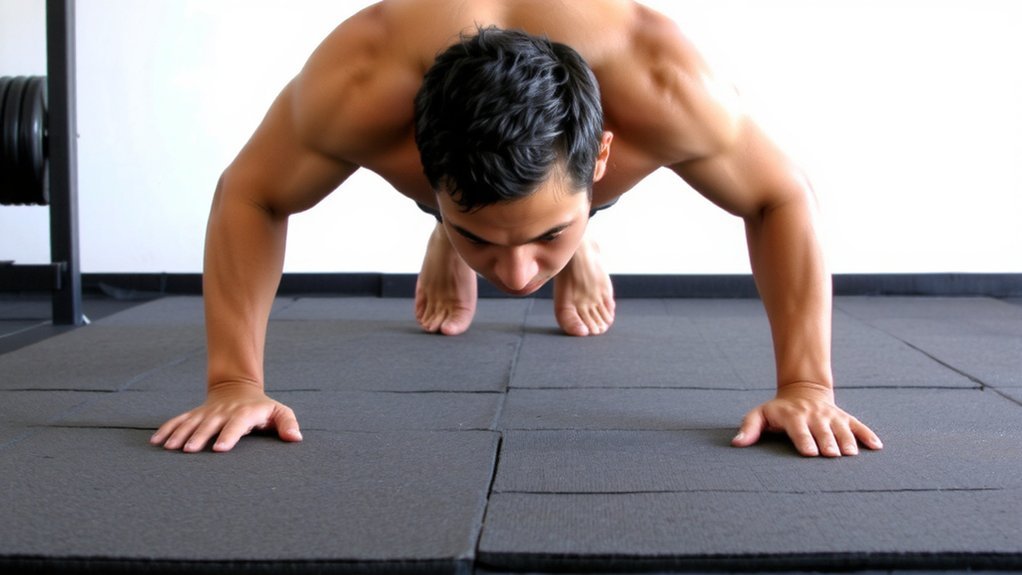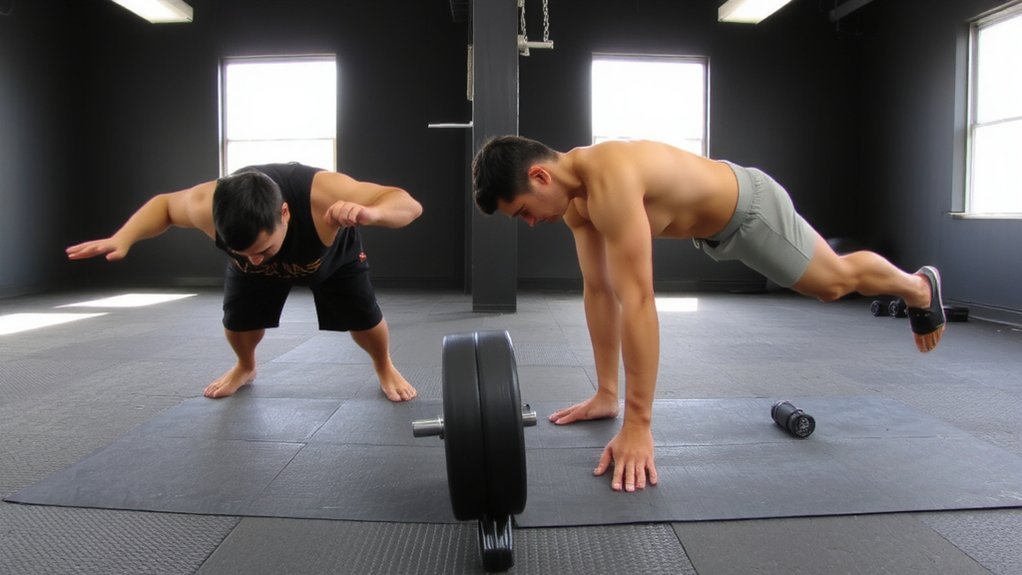You can master the push-up by setting up with hands just outside shoulder width, feet hip-width, and a braced core so your body stays straight. You’ll lower under control until your chest nears the floor, then press up while keeping the neck neutral and shoulders engaged. Learn a few tweaks and progressions that fix common errors and boost strength—but first, check your form.
Setup and Body Position

Before you lower yourself, set a solid foundation so your push-up works the muscles and protects your joints. Plant your feet hip-width or slightly narrower, press through the balls of your feet, and align your ankles, knees, hips and shoulders so your body forms a straight line.
Brace your core and tilt your pelvis slightly to avoid sagging or an exaggerated arch. Pull your shoulder blades down and back to stabilize the upper torso and reduce strain.
Keep your neck neutral by looking slightly ahead, not tucking or craning. Inhale as you prepare, exhale as you push, and control the tempo—steady descent and a deliberate rise.
Check alignment in a mirror or record yourself for quick feedback. You’ll see flaws and fix them faster.
Arm and Hand Positioning

With your body aligned, your arms and hands become the levers that move you—place your hands slightly wider than shoulder-width, fingers splayed for stability, and point them forward or slightly outward to match your shoulder comfort.
Keep your wrists neutral by pressing through the base of your palm and fingertips so you don’t overextend the wrist joint.
Position elbows so they track roughly under or slightly behind your shoulders; this protects joints and engages chest and triceps efficiently.
If your wrists hurt, make fists or use dumbbell handles to keep a straight wrist. Narrower hands emphasize triceps, wider hands shift load to chest—choose a grip that feels strong and pain-free. Maintain consistent hand placement across reps for predictable loading and joint safety and stability.
Movement Execution and Range of Motion

When you lower yourself, control the descent so your body stays in a straight line and you don’t bounce at the bottom. Aim to descend until your chest hovers just above the floor or your elbows reach roughly 90 degrees; that gives a full, safe range of motion.
Pause briefly at the bottom—one short breath—then press steadily until your elbows reach near full extension without locking. Use a measured tempo: two counts down, one count pause, one to two counts up.
If full depth feels unsafe, reduce range by placing hands on an elevated surface and progress as strength improves. Track quality over quantity: clean reps with consistent range will build strength and reduce injury risk. Rest between sets and increase load progressively, safely.
Core, Shoulder, and Scapular Engagement

Good control through each rep depends on more than arm strength; your core, shoulders, and scapulae have to work together to keep your body rigid and protect your joints. Brace your midline as if expecting a light punch — draw your belly toward your spine, maintain neutral hips, and avoid overarching or sagging.
Actively depress and retract your shoulder blades slightly at the top, then allow controlled protraction as you lower so the scapulae move smoothly. Engage the lats to support the shoulder girdle and distribute load away from the anterior capsule.
Breathe steadily: exhale as you press, inhale as you lower. Practice slow, deliberate reps focusing on tension through the trunk and shoulder complex; that coordinated engagement scales effort and reduces strain progressively.
Common Mistakes to Avoid

In and around your shoulders and core, small errors add up fast and wreck your form. Don’t let common faults undermine reps.
Keep a neutral spine—avoid sagging hips or a raised butt. Don’t flare elbows wide; tuck them around 45 degrees to protect shoulders.
Stop shrugging into your ears; retract and depress your scapula before lowering. Control descent and avoid bouncing off the floor or rushing the concentric; tempo matters.
Watch hand placement: too wide or too narrow changes loading and risks strain. Don’t crane your neck—look slightly ahead, not down or up.
Breathe rhythmically; don’t hold it. If one side dominates, pause to check symmetry.
Fixing these keeps push-ups safe and effective. Focus on quality over quantity for consistent, sustainable progress and safety.
Progressions and Modifications
Because push-ups tax many muscles, you should match the version to your current strength and goals and change it gradually as you improve.
Start with assisted options if full push-ups feel too hard: perform incline push-ups against a bench, wall push-ups, or knee push-ups to reduce load and practice bracing.
To increase challenge, lower the surface or progress to full push-ups, then add tempo changes like slow eccentrics, pause holds at the bottom, or elevated feet for decline push-ups.
Use resistance bands for support or added load.
Modify hand placement—wide for chest emphasis, narrow for triceps—or add instability like a suspension trainer for core demand.
For advanced overload, try weighted vests, plyometric reps, or single-arm variations once balance and strength allow, and reduce injury.
Programming and Practice Tips
How often should you practice push-ups?
Aim for three sessions weekly if you’re building strength, or four to six if you’re focusing on endurance.
Balance intensity: mix heavy sets (near max reps or added resistance) with lighter, higher-rep days.
Use progressive overload—add reps, sets, or resistance every one to three weeks.
Include variety: standard, incline, decline, and tempo variations to target muscles and prevent plateaus.
Prioritize form over volume; stop sets before form breaks.
Rest: give muscles 48 hours between intense chest-focused sessions.
Track sessions and reps so you can adjust load and recovery.
Deload every fourth week by reducing volume or intensity to let your body adapt.
Stay consistent; gradual, measurable progression beats sporadic effort.
Check technique periodically with a coach or video.
Conclusion
Now that you know proper setup, hand placement, movement, and engagement, practice push-ups with mindful form: hands just wider than shoulders, feet hip-width, neutral neck, braced core, and scapula control. Lower with control to about 90 degrees, breathe in, pause, then press up without locking out while tracking elbows at roughly 45 degrees. Avoid sagging, flaring, or rushing. Use progressions or modifications as needed, and practice consistently to build strength and lasting technique and confidence.